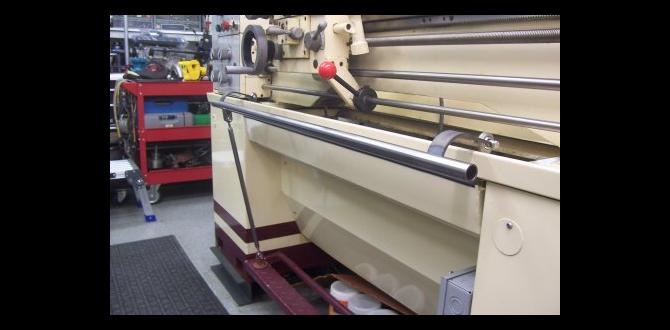For cutting brass with a 1/8″ carbide end mill, choose a mill designed for softer metals, use appropriate speeds and feeds, secure your workpiece firmly, and maintain a light touch to prevent chatter and achieve clean, precise cuts.
Working with brass can be incredibly rewarding, giving your projects a beautiful, golden sheen. But cutting brass can also be a bit tricky, especially when you’re starting out. One of the most common hiccups happens when using a small end mill, like a 1/8″ carbide tool, and the result is annoying chatter, rough cuts, or even a broken bit. It’s really frustrating when your workpiece ends up looking worse than when you started! Don’t worry, though; this is a super common situation for beginners, and it’s totally fixable with the right knowledge and a few simple techniques. We’ll go through everything you need to know, step-by-step, to get those clean, perfect cuts you’re aiming for. Let’s dive in!
Mastering the 1/8″ Carbide End Mill for Brass: Your Beginner’s Guide
Brass is a fantastic material for hobbyists and makers. It’s relatively soft, machines easily, and ages beautifully. However, its unique properties also mean it can present challenges, especially when using small-diameter cutting tools like a 1/8″ carbide end mill. The main culprit for trouble is often chatter – that nasty vibration that leaves marks on your material and can even damage your cutting tool. This guide will walk you through selecting the right tool, setting up your machine, and the precise techniques needed to cut brass cleanly and efficiently with a 1/8″ end mill.
Why is Cutting Brass with a Small End Mill Tricky?
A 1/8″ end mill is a wonderfully versatile tool, perfect for intricate details and smaller projects. However, its small size means it has less rigidity compared to larger cutters. When milling brass, a material that can be a bit “gummy,” this lack of rigidity can easily lead to vibrations, or chatter. Factors contributing to this include:
Tool Runout: Even tiny wobbles in the spindle can be magnified with a small cutter.
Material Stickiness: Brass can sometimes “gum up” on the cutting edges, increasing cutting forces.
Feed Rate and Speed: Incorrect speeds and feeds are the biggest culprits for chatter.
Workpiece Clamping: A loose workpiece will vibrate along with the cutter.
Tool Length: Longer tools are more prone to deflection and vibration.
Understanding these issues is the first step to overcoming them.
Choosing the Right 1/8″ Carbide End Mill for Brass
Not all carbide end mills are created equal, and for brass, you need one specifically suited for softer, more yielding materials. Here’s what to look for:
Key Features to Consider:
Number of Flutes: For brass, fewer flutes are generally better. A 2-flute end mill is often the go-to choice. Why? Each flute has more space to clear chips effectively. With brass, chips can be long and “stringy,” and good chip evacuation is crucial to prevent them from packing up, leading to increased friction, heat, and chatter. A 3-flute or 4-flute mill can work, but they require more careful management of speeds and feeds to ensure good chip load per flute.
Flute Geometry: Look for end mills with a high helix angle and a polished flute finish. A high helix angle (often 30-45 degrees) helps to “slice” through the material more smoothly, reducing cutting forces and promoting better chip evacuation. A polished flute finish reduces friction and helps prevent brass from sticking to the cutter.
Coating: For milling brass, an uncoated carbide end mill is often preferred. Coatings, while great for harder materials, can sometimes increase friction or adhere to softer metals like brass, leading to build-up and poor performance.
Reduced Neck (Optional but Recommended): Some 1/8″ end mills designed for brass feature a “reduced neck” or “straight shank reduced neck.” This means a portion of the shank just above the cutting flutes is slightly smaller in diameter than the cutting diameter. This design provides clearance for deeper cuts and can help reduce the chance of the shank rubbing against sidewalls or chips, further minimizing chatter.
Material: Carbide is excellent for its hardness and ability to hold an edge at higher speeds, which is beneficial for brass. However, ensure it’s a good quality carbide suitable for machining non-ferrous metals.
Recommended End Mill Types for Brass:
- 2-Flute, High Helix, Polished Finish: This is your workhorse for brass. It offers excellent chip clearance and a smooth cutting action.
- Uncoated Carbide: Avoid coatings that are designed for steel or aluminum, as they can cause issues with brass.
- End Mills with a Slightly Negative Rake Angle: While many beginner guides suggest specific rake angles, for general brass milling with a 1/8″ end mill, focusing on flute count, helix angle, and finish will yield better results than worrying about rake for a first pass.
Critical Setup and Safety First!
Before you even think about turning on your machine, preparation is key. Safety is paramount in any machining operation, and milling is no exception.
Essential Safety Gear:
- Safety Glasses: Always wear ANSI Z87.1-approved safety glasses that fully cover your eyes. A full face shield is even better when milling.
- Hearing Protection: Milling can be noisy; use earplugs or earmuffs.
- No Loose Clothing or Jewelry: Tuck in shirts, remove necklaces, bracelets, and rings. Tie back long hair.
- Gloves (with caution): While not always recommended around rotating machinery, if you must use gloves, ensure they are snug-fitting and consider that they can sometimes reduce dexterity and feel when handling tools.
Workpiece Clamping: The Foundation of Good Cuts
A securely held workpiece is non-negotiable. Any movement or vibration from the material itself will contribute to poor cut quality and chatter.
Use Vises: A good quality milling vise is essential. Ensure the vise jaws are clean and free of debris. Use soft jaws if you’re concerned about marring the surface of your brass.
Clamps: For larger or irregularly shaped pieces, use strap clamps or toe clamps to secure the workpiece to the milling table. Ensure clamps have sufficient surface contact and are tightened firmly but not so much that you deform the workpiece.
Consider Fixturing: For repetitive tasks or very precise work, custom fixtures can provide the most rigid support.
Placement: Position your workpiece so that the cutting forces are directed downwards into the table as much as possible, or at least resisted by the solid structure of the vise or clamps.
Machine Setup Essentials:
- Cleanliness: Ensure your milling machine table, vise, and spindle are clean and free of chips and debris.
- Collet or Tool Holder: Use a high-quality collet or tool holder for your 1/8″ end mill. A worn or runout collet is a guaranteed way to introduce vibration. Ensure the collet is the correct size for your shank (usually 1/8″ or 3mm, 6mm for the larger shank on some “6mm shank reduced neck” types).
- Spindle Runout: Ideally, check your spindle runout with an indicator. Minimal runout is crucial for small cutters. Clean the collet and spindle taper thoroughly before inserting the collet.
Speeds and Feeds: The Secret Sauce for Smooth Brass Cutting
This is where many beginners struggle. Finding the right balance of spindle speed (RPM) and feed rate (how fast the tool moves through the material) is critical for chatter-free brass milling.
Understanding RPM and Feed Rate
Spindle Speed (RPM): This is how fast the spindle (and the tool) rotates. Too fast, and you generate excessive heat and can burn the brass or melt chips. Too slow, and you can dig into the material and cause chatter.
Feed Rate: This is often expressed in inches per minute (IPM) or millimeters per minute (mm/min). It’s how fast your machine’s axis moves the tool through the workpiece. A proper feed rate ensures each flute “loads” with a sufficient chip of material.
General Guidelines for 1/8″ Carbide End Mills in Brass:
The exact speeds and feeds depend on your specific machine, the exact alloy of brass, and the end mill geometry. However, here are some starting points using a 2-flute, uncoated carbide end mill:
Surface Speed (SFM – Surface Feet per Minute): For brass with carbide, a surface speed of 150-300 SFM is a good starting point. To convert this to RPM for your 1/8″ (0.125″) diameter tool:
RPM = (SFM 3.25) / Diameter (inches)
Using 200 SFM: RPM = (200 3.25) / 0.125 = 5200 RPM
Using 300 SFM: RPM = (300 3.25) / 0.125 = 7800 RPM
So, a starting spindle speed range of 5000 – 7500 RPM is common for a 1/8″ end mill in brass. If your machine can’t reach these speeds, you might need to slow down your feed rate accordingly.
Chip Load (ITP – Inches per Tooth): This is the thickness of the chip each cutting edge removes. For brass with a 1/8″ carbide end mill, a chip load of 0.0005″ to 0.0015″ per tooth is a good target. With a 2-flute end mill:
Feed Rate (IPM) = RPM Chip Load Number of Flutes
At 6000 RPM, 0.001″ chip load, 2 flutes: Feed Rate = 6000 0.001 2 = 12 IPM (approximately 300 mm/min)
At 7000 RPM, 0.0015″ chip load, 2 flutes: Feed Rate = 7000 0.0015 2 = 21 IPM (approximately 530 mm/min)
Table: Recommended Starting Speeds and Feeds for 1/8″ Carbide End Mill in Brass
| Parameter | Value Range (for 1/8″ Carbide End Mill) | Notes |
| :————— | :————————————– | :——————————————————————– |
| Spindle Speed | 5,000 – 7,500 RPM | Higher speeds can be used if cooling is adequate. |
| Chip Load/Tooth| 0.0005″ – 0.0015″ | Start conservatively and increase if cuts are smooth. |
| Feed Rate | 8 – 25 IPM (approx. 200 – 630 mm/min) | Adjust based on RPM and desired chip load. Listen for chatter. |
| Depth of Cut | Light (e.g., 0.010″ – 0.050″) | Start shallow, especially in full slots. Avoid heavy plunging. |
| Width of Cut | 0.030″ – 0.120″ (25% – 100% of diameter) | Partial width cuts (e.g., 50%) are often smoother. Climb milling is key. |
Important Note: These are starting points. Always listen to your machine. If you hear chatter, slow down the feed rate or reduce the depth of cut. If the chips look tiny and wispy, you might need to increase the feed rate or RPM slightly. If chips are melting or welding to the tool, you’re likely going too fast (RPM too high) or not clearing chips well.
Coolant/Lubrication: Essential for Brass
While some machinists might prefer dry machining brass, using a cutting fluid specifically designed for aluminum or brass can significantly improve results.
Benefits: Coolant reduces friction, prevents chips from welding to the tool, improves tool life, and helps with chip evacuation.
Types: A light flood of cutting fluid or a mist coolant system is ideal. For hobbyists, a spray can of specialized cutting fluid for aluminum or brass can work wonders. Apply it directly to the cutting area. A simple solution of light oil and mineral spirits can also work in a pinch, but dedicated fluids are better. For more advanced setups, a flood coolant system is highly recommended.
You can find excellent resources on speeds and feeds from organizations like the Seco Tools Material Data Sheet for Brass or by consulting manufacturer data for your specific end mills.
Cutting Techniques for Clean Brass Removal
With the right tool, setup, and speeds/feeds, you’re ready to start cutting. Here’s how to approach it for the best results.
Climb Milling vs. Conventional Milling
This is a critical distinction for milling operations, especially with small cutters.
Conventional Milling: The cutter rotates against the direction of feed. This tends to push the workpiece away from the cutter and can lead to rougher surface finishes and more chatter.
Climb Milling (Also called “Down Milling”): The cutter rotates in the same direction as the feed. This pulls the workpiece into the cutter, resulting in less chatter, a smoother finish, and better mating of the chip’s thickness.
For milling brass with any end mill, especially a 1/8″ one, climb milling is almost always preferred. You’ll generally get cleaner cuts and less chatter. Be aware that climb milling puts different forces on your machine’s feed mechanisms; older machines with worn leadscrews might be better suited to conventional milling, but if your machine has backlash compensation or is in good condition, climb milling is the way to go for brass.
Step-by-Step Milling Process:
1. Secure Your Workpiece: Ensure it’s clamped down rigidly in your vise or on the table.
2. Install the End Mill: Insert the clean 1/8″ carbide end mill into a clean collet and tighten it securely in the spindle.
3. Set Your Zero/Origin: Using an edge finder or probe, establish your X, Y, and Z zero points on the workpiece. For Z, this is typically the top surface of the brass.
4. Program or Manually Set Your Toolpath: This will depend on whether you’re using a CNC mill or a manual machine.
5. Engage Spindle and Coolant: Start your spindle at the programmed RPM and turn on your coolant or lubricant.
6. Plunge (if necessary): If you need to start a cut in the middle of the workpiece (making a pocket or hole), plunge the end mill down slowly. Start with a shallow plunge depth and a feed rate much slower than your typical side milling feed rate (e.g., 3-5 IPM). Some specialized “chipless” or “high-performance” end mills are designed for rapid plunging, but for standard 1/8″ cutters, slow and steady is best here.
Tip: When plunging to a specific depth, plunge the tool just to the surface of the workpiece (Z zero) and then retract it slightly before commencing the side milling. This often results in a cleaner entry.
7. Begin Side Milling (Climb Milling Preferred):
Start your feed in the direction of climb milling. Engage the feed smoothly.
Depth of Cut: For your first pass, take a light radial depth of cut (e.g., 25-50% of the end mill diameter, so 0.03″ – 0.06″ for a 1/8″ mill) and a shallow axial depth of cut (e.g., 0.010″ – 0.030″). This is crucial for minimizing chatter.
Listen and Observe: Pay close attention to the sound and feel of the cut. Smooth, consistent cutting noise is good. Any chattering, squealing, or stalling indicates a problem.
8. Manage Chip Load: Ensure you’re achieving a good chip load. You should see small, well-formed chips being ejected. If chips are tiny or not being cleared, adjust your feed rate or RPM.
9. Multiple Passes for Deeper Pockets: To mill deeper pockets or slots, take multiple shallow passes rather than one deep pass. For example, to mill to a depth of 0.1″, you might make three passes at 0.033″ depth each. This greatly reduces the cutting forces on each pass and minimizes chatter.
10. Finishing Pass: For critical dimensions or a super smooth surface finish, consider taking a final “spring pass” at a very shallow depth of cut (e.g., 0.001″ – 0.002″) at your final programmed dimensions. This pass cuts slightly undersize and uses the tool’s rigidity to achieve higher accuracy and a better finish.
11. Retract





